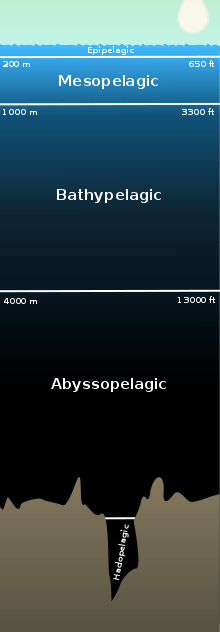Bathyal zone
The bathyal zone or bathypelagic – from Greek βαθύς (bathýs), deep – (also known as midnight zone) is the part of the pelagic zone that extends from a depth of 1,000 to 4,000 m (3,300 to 13,100 ft) below the ocean surface.[1][2] It lies between the mesopelagic above, and the abyssopelagic below. The average temperature hovers at about 4 °C (39 °F). Although larger by volume than the photic zone, the bathyal zone is less densely populated. Sunlight does not reach this zone, meaning primary production, if any, is almost nonexistent. There are no known plants because of the lack of sunlight necessary for photosynthesis. It is known as the midnight (also twilight or dark) zone because of this feature.[1]
| Aquatic layers |
|---|
| Stratification |
| See also |

Fauna
Because of the lack of light, some species do not have eyes. Those possessing eyes in this zone include the viperfish and the frill shark. Many forms of nekton live in the bathyal zone, such as squid, large whales, and octopuses. In the bathyal, some of the world's largest whales feed. Sponges, brachiopods, sea stars, and echinoids are also common in the bathyal zone. Animals in the bathyal zone are not threatened by predators that can see them, so they do not have powerful muscles. This zone is difficult for fish to live in since it is especially hard to find nutrients. They have become very energy efficient, and many have slow metabolic rates to conserve energy. The fish are characterized by weak muscles, soft skin, and slimy bodies. The adaptations of some of the fish that live there include small eyes and transparent skin.
Except where the ocean is exceptionally deep, the bathyal zone extends to the benthic zone on the ocean bed of that part of the continental slope that lies between 1000 and 4000 meters deep. The bathyal zone contains sharks, squid, octopuses, and many different species of fish. This includes deep-water anglerfish, gulper eel, amphipods and dragonfish.
Hydrothermal Exploration
The bathyal zone is of interest to those studying biogeochemistry or deep sea mining. As of 2013, the majority of visually-confirmed hydrothermal vents are located at depths of 1,000 metres (3,300 ft) to 4,000 metres (13,000 ft).[3] Hot venting fluids are buoyant and can rise a considerable distance in the water column, supplying hydrogen, methane, sulfur, and iron to organisms in the bathypelagic.
References
- "Bathypelagic zone". Layers of the ocean. National Weather Service. Archived from the original on 7 February 2017. Retrieved 28 June 2017.CS1 maint: BOT: original-url status unknown (link)
- Morelle, Rebecca (7 October 2008). "Deepest ever' living fish filmed". BBC News. Retrieved 5 June 2017.
- Beaulieu, Stace E.; Baker, Edward T.; German, Christopher R.; Maffei, Andrew (November 2013). "An authoritative global database for active submarine hydrothermal vent fields". Geochemistry, Geophysics, Geosystems. 14 (11): 4892–4905. doi:10.1002/2013GC004998. hdl:1912/6496.
- Enig, C. C. (1997). Bathyal zones on the Mediterranean continental slope: An attempt. Research on marine benthos: 9th Iberian Symposium on Studies of Marine Benthos. Madrid: MAPA, SGT. pp. 23–33. ISBN 8449102995.
External links
- Bathyal zone (oceanography) Encyclopædia Britannica Online. 21 March 2009.